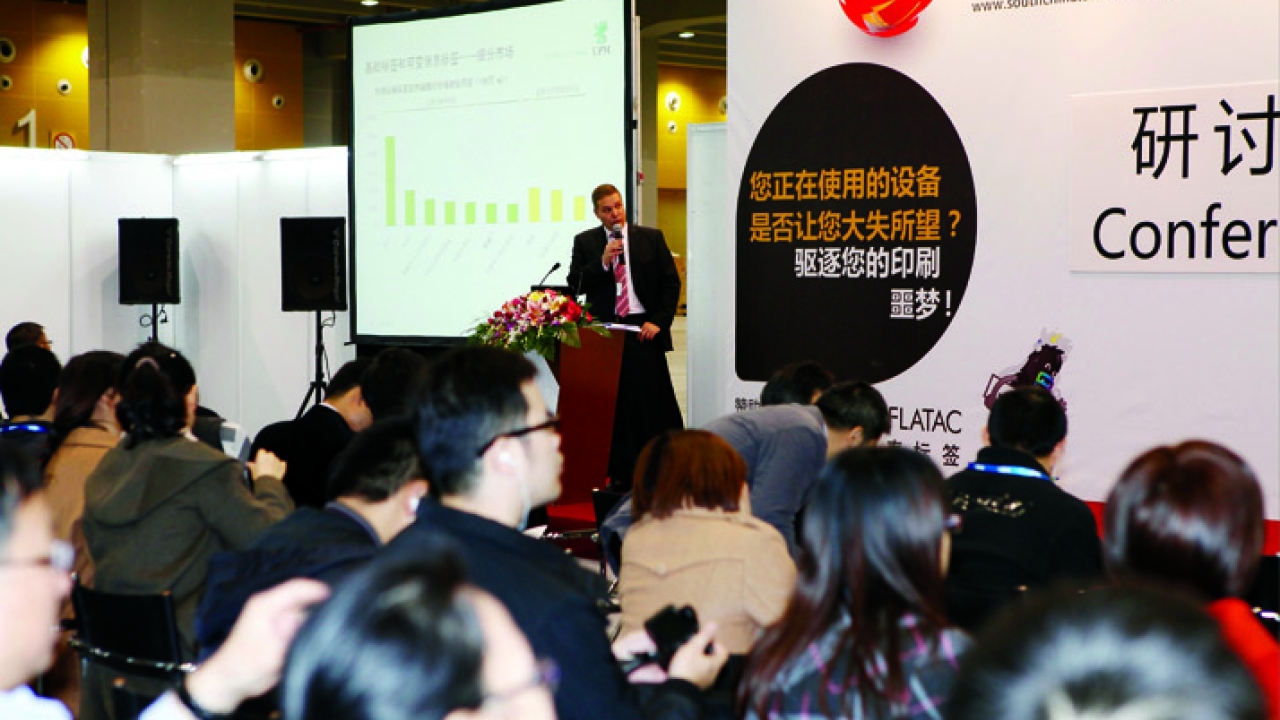Success in South China

The South China Label Show 2012 attracted over 5,000 visitors as its second edition was held in Guangzhou last December. Andy Thomas reports
While Labelexpo Asia attracts Chinese label converters primarily from the industrial concentrations around Shanghai and Beijing, converters from the vast and growing industrial areas in the South of the country are often reluctant to travel northwards.
For this reason Tarsus launched the South China Label Show in Guangzhou in 2010, and this second edition proved the validity of the concept.
Attendance was up by 26.8 percent over 2010’s figure of 4,021. Exhibitor numbers increased from 90 to 150, with 26 new companies exhibiting for the first time. Before the show ended, the organizers reported a space rebook for 2014 of 28 percent.
Commented John Davy, sales director for the South China Label Show: ‘Such a large increase in visitor and exhibitor numbers clearly underlines the show’s growing importance in the South China region. With numerous exhibitors reporting strong sales and the news of at least 25 units being sold at the show it confirms its position as an effective platform for sales and networking.’
Conference sessions
As well as a busy exhibition show floor, which featured demonstrations of 29 pieces of machinery and 15 working presses, the South China Label Show also featured six well-attended conference sessions.
The keynote presentation was given by Jukka-Pekka Haapanen, vice president Asia Pacific at UPM Raflatac, who compared global market trends and explored emerging trends and best practices in China.
Haapanen said the growth seen in China is part of a major shift in economic activity from developed to developing economies. ‘At least 80 percent of growth between 2010-2020 will come from emerging markets and the Indian and China markets will triple in size. By 2025 the Chinese market reaches the same size as the US.’
Adoption of pressure sensitive labels in China – as well as India and Brazil – is being driven mainly by the food and beverage sectors, said Haapanen, although there remains some price resistance to moving from wet glue. Key trends which will drive PS adoption in China include an increased focus by the Chinese government on food safety, following recent food scares in the country.
The Chinese converter sector remains quite fragmented, said Haapanen. While in Europe the top 10 converters account for 17 percent of the market, in China the top 10 serve less than 10 percent of the market.
A presentation by brand security expert Du Zhenlin, president of the Shenzhen Association of Anti-Counterfeiting, took a hard look at the problems faced by brands in China along with possible solutions.
‘Customers want a one-stop solution – there is a great demand for labels with anti-counterfeit features – but they still want a cheap price. The question is how can we get a fair price and get the customer to see the value of an anti-counterfeit label? ‘
Du Zhenlin gave a real example of a top quality wine where the packaging was authentic but the wine inside fake. ‘It is very easy to manufacture new bottle caps!’ What was wanted were packages unable to be reused. An extraordinary offer was made: ‘We made a proposal to the winery that we would be responsible for any counterfeits which appeared after our solution was adopted, and this was accepted.’ A team was formed with the bottle vendor and other suppliers. A wraparound anti-counterfeit label was developed which incorporates its own authentication device. The label has to be broken to open the wine, at which point it loses the ability to be authenticated. It cannot be stuck to another surface and made active. ‘Customers only need to make sure the anti-counterfeit label is present when they buy the wine.’
So Du Zhenlin’s solution is for label converters to take on some of the risk faced by their customers in adopting an anti-counterfeit solution. ‘That way they will be prepared to pay for more than a piece of paper.’
Alongside these presentations was one on package printing from Federico d’Annunzio, md of Nuova Gidue, and one on market opportunities for high quality wine and beverage labeling by Manter’s Christian Galí. The second day included a case study on investing in digital technologies jointly presented by Hendry Feng, sales manager – labels and packaging segment with China Hewlett-Packard, and Top Print Labels’ founder and deputy chairman Henrich Quek. The sessions concluded with a focus on sustainability from Carmen Chua, vice president – marketing, Avery Dennison Materials Group Asia Pacific, including a fascinating case study of a dairy in Seoul which adopted PS labels from a sustainability perspective.
Pictured: Jukka-Pekka Haapanen, vice president Asia Pacific at UPM Raflatac, gives the keynote presentation at South China Label Show
This article was published in Labels & Labeling issue 1, 2013
Stay up to date
Subscribe to the free Label News newsletter and receive the latest content every week. We'll never share your email address.


